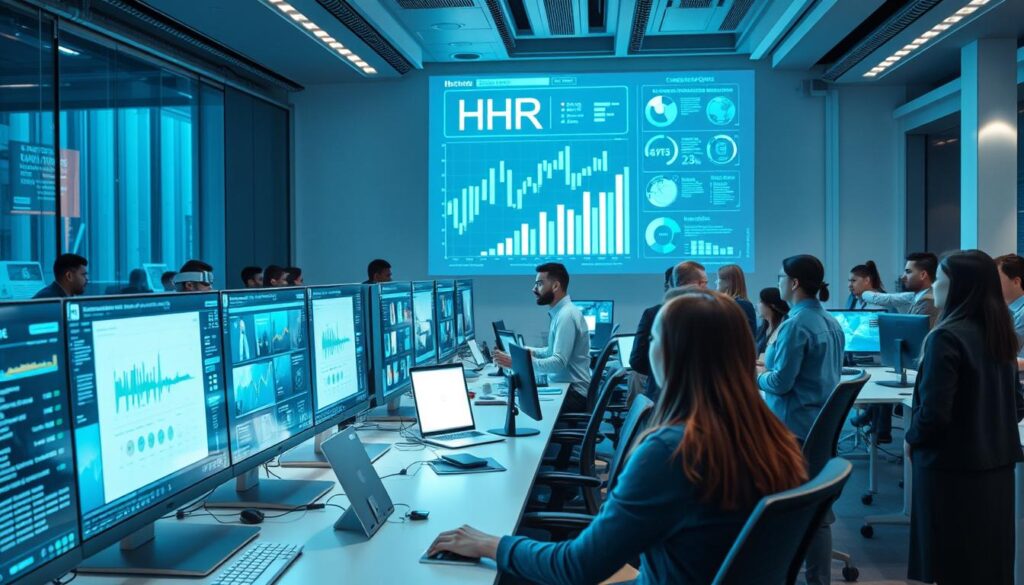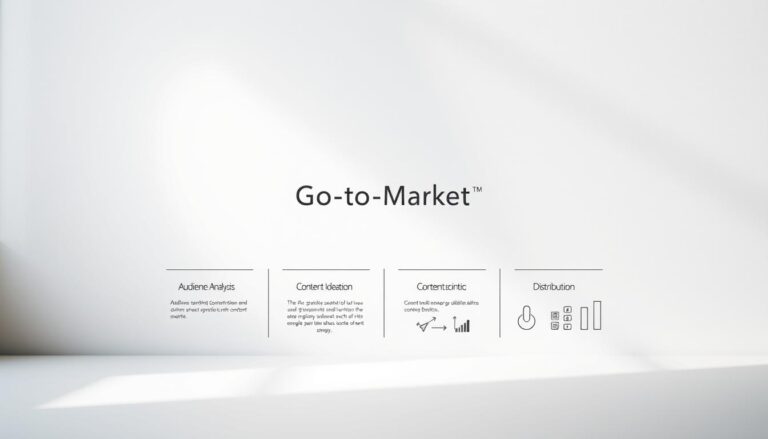Businesses today aim to make HR more efficient and improve HR processes. They are focused on streamlining human resources operations due to many complex demands. These demands come from both employees and top leaders. A key study by McKinsey highlights the role of automation in this area. It shows that 56 percent of HR tasks can be automated. This big change helps make work flow smoother and saves a lot of time and money.
Key Takeaways
- Automation can lead to a 66% reduction in HR processing time, according to McKinsey.
- Transitioning to automated systems reallocates valuable labor towards strategic roles within the company.
- Adoption of cloud-based HR tools enhances real-time workforce data analysis.
- Employee self-service portals significantly unburden HR departments from repetitive tasks.
- Unified HR and payroll systems minimize errors and enhance data integrity.
- A focused approach to streamlining HR operations elevates overall organizational productivity and workforce support.
- Advanced data analytics enable HR decisions driven by accurate, real-world employee data.
Understanding the Importance of Streamlining HR Operations
To improve HR management, we need to know what streamlining HR means. It’s all about making HR processes simpler and more effective. It covers everything from hiring to saying goodbye to employees. This change boosts HR’s work and helps achieve bigger company goals.
What Does Streamlining Mean?
Improving HR involves looking closely at and bettering key processes. This means making routine tasks automatic, keeping employee info in one place, and using better HR systems to lower the workload. Doing this saves time and money, letting businesses focus on more important projects.
Benefits to the Organization
Streamlining HR brings many perks to companies. It makes repetitive tasks automatic and organizes info better, raising both speed and quality. For example, using cloud services improves data safety and makes team work from different places easier. This boosts work flow and flexibility.
Such changes in HR give many direct benefits to a company:
- Improved compliance due to quicker and more precise data handling.
- Lower operational costs through better process handling.
- Better employee happiness and loyalty thanks to smoother HR work.
- More strategic thinking among HR staff, moving away from paperwork to focusing on key business aims.
Moreover, bringing in Employer of Record (EOR) services keeps companies in line with legal needs. This is super important for companies going global. They need to handle different labor laws and manage workers worldwide.
| Feature | Benefits |
|---|---|
| Centralized Employee Data | Improves data accuracy, security, and access. |
| Automated Routine Tasks | Reduces time on manual processes, eliminates bottlenecks. |
| EOR Integration | Enhances compliance, assists in international workforce management. |
| Cloud-Based Systems | Enables remote access, facilitates better collaboration. |
To better HR management, companies must always look for ways to make HR work better. Staying committed to this not just helps HR but strengthens the whole company.
Key Challenges in HR Operations
In human resources, it’s crucial to be efficient, especially today. Our work spaces and economies are changing fast. HR challenges like HR workflow optimization and cutting down on HR operational bottlenecks are very important. Outdated systems and increasing workforce demands make these challenges even bigger.
Inefficiencies in Traditional Processes
Old HR methods depend too much on manual work and paper. This causes delays and risks mistakes in key areas like payroll and compliance. These old systems make things slow and hinder good HR workflow optimization. For example, ManpowerGroup found that 75% of businesses struggle to fill positions due to inefficient hiring practices.
High Employee Turnover
Bad HR processes lead to lots of employees leaving. Studies show that 40% of poorly trained employees quit in their first year. This turnover costs a lot—between $30,000 to $45,000 to replace a manager. It’s bad for the company’s morale and productivity.
Fixing high turnover and bettering employee engagement go hand in hand. Stats say 71% of leaders think employee engagement is key for success. Yet, 82% of employees might feel burnt out by 2024. This burnout may come from unclear work-life boundaries. In remote and hybrid work, 12.7% are fully remote, and 28.2% are in a hybrid setting.
| Challenge | Impact on HR | Cost to Organization |
|---|---|---|
| Inadequate Training | Increases employee turnover | $30,000 to $45,000 per manager |
| Manual Processes | Compliance risks, payroll errors | $2,600 to $3,600 per employee annually |
| Burnout from Non-Optimal Work-Life Balance | Decline in productivity and mental health | Significant, including potential loss of top talent |
With these tough HR challenges, making operations smoother is a must. Businesses need to adopt advanced HR solutions. These should fix the problems and help with long-term growth and employee happiness.
Best Practices for Streamlining HR Operations
To make HR operations more efficient, there are key practices to follow. These focus on improving efficiency and lessening the manual workload. They do this by using HR automation solutions and implementing HR technology.
Automating Routine Tasks
Automating common tasks is key to making HR operations smoother. With HR automation solutions like HRIS, businesses can handle important jobs automatically. From managing employee info to keeping track of attendance. This cuts down mistakes from entering data by hand. It also lets HR pros spend more time on big-picture tasks instead of day-to-day chores.
Implementing Cloud-Based HR Solutions
Using cloud-based HR technology is another important step. These systems let you access data anytime, anywhere, which helps in making smart choices. They also improve how HR systems work together. Good HRIS systems offer insights into how employees are doing. These can be checked from anywhere, making things more flexible and productive.
Standardizing Procedures
Making HR procedures the same across the board helps manage HR activities consistently. This boosts consistency and reliability within the company. When you combine standard procedures with HR system integration, it keeps how employees’ data and performance reviews are handled uniform.
By adopting these practices, businesses are not only making their HR operations smoother. They are also leading the way in their fields for efficient and effective HR management.
Leveraging Technology in HR
Advanced technology is changing human resources fundamentally, making HR more important. Companies use HR software solutions and workforce management software to automate tasks. This makes operations and strategy more effective.
HR Software and Tools
HR software solutions are changing how HR works. They make tasks like hiring and performance reviews easier. For example, 86% of HR experts say that using Applicant Tracking Systems (ATS) improves hiring. Popular ATS include BambooHR, JazzHR, and ApplicantPro.
Tools like GoCo, Paycor, and Paylocity automate payroll, cutting down mistakes. With AI growing in HR, these tools will become crucial for smart decisions and efficiency by 2025.
Data Analytics for Better Decision-Making
HR data analytics let companies make choices based on current data. These analytics look at things like employee turnover and engagement. They help see trends and manage workforce issues better.
Data tools help with analyzing employee healthcare costs. This helps in offering cost-effective benefits. Platforms like Lattice and Trakstar help with ongoing feedback and setting goals. These are key for a motivated team.

More than half the companies use tech to improve training. Systems like Biz Library and Cornerstone OnDemand are vital for a skilled workforce. They help manage and track learning effectively.
| Feature | Impact | Tool/Software |
|---|---|---|
| Applicant Tracking | Streamlines hiring, improves success rate | BambooHR, JazzHR |
| Payroll Automation | Reduces errors, saves time | Paycor, Paylocity |
| Performance Management | Facilitates feedback, enhances productivity | Lattice, Trakstar |
| Learning Management | Centralizes training resources, tracks progress | Biz Library, Cornerstone OnDemand |
| Data Analytics | Drives strategic decisions, predicts trends | HR analytics tools |
Using workforce management software and HR data analytics makes HR tasks smoother. It also boosts HR’s strategic role. This improves work culture and puts HR central to business strategy and success.
Enhancing Communication in HR
The role of human resources is crucial for effective communication in businesses. The strategic use of communication in HR makes roles clear and boosts efficiency. It explores how modern collaboration tools and HR feedback loops can improve HR operations.
Utilizing Collaboration Platforms
In our digital world, using collaboration tools is key for better communication in HR. Platforms like Slack, Microsoft Teams, and Zoom help teams talk and work together across places. They allow messaging, video calls, and file sharing, which are important for making quick and effective HR decisions.
Regular Feedback Mechanisms
It’s important to have regular HR feedback loops to understand employees’ feelings and make HR responsive. Through surveys, one-on-one chats, and suggestion boxes, feedback is gathered. These methods let HR quickly find and fix problems affecting employee happiness, culture, and work efficiency. They help build a happier and more productive team.
Using advanced HR software can improve communication in HR by handling tasks like payroll and data automatically. This lets HR pros concentrate on strategic tasks such as managing talent and keeping employees engaged. Digital tools also make communication transparent and open, important for a united team.
Enhancing HR communication with collaboration tools and HR feedback loops not only makes HR work smoother. It also supports a flexible and evolving company culture.
Training and Development Strategies
Enhancing HR training and developing HR skills is key in keeping up with changes at work and tech. In the last few decades, HR has moved from traditional training to designing learning environments. These promote ongoing growth and help achieve excellence at work.
Continuous Learning Opportunities
Companies are investing more in training to keep up with the modern workforce and tech changes. Training has shifted from old methods to dynamic online platforms. This change aims at providing customized learning experiences. Companies embracing ongoing learning see a rise in employee performance and creativity.
Also, using the latest training methods helps make onboarding better, readying employees for their new roles well. Surprisingly, only 29% of employees feel fully ready after onboarding. This highlights the need for better training programs. Learn how to streamline HR processes and.

Onboarding Best Practices
To improve onboarding, top companies use standard procedures to help new hires adjust and become productive faster. This includes onboarding checklists and training incentives linked to development goals. It boosts motivation and shows appreciation from the start.
Research shows that good training programs can increase a company’s profits per employee by 218%. This links HR training strategies directly to business success. It shows how important it is to invest in proper onboarding and ongoing education.
| Aspect | Impact |
|---|---|
| Comprehensive Onboarding | Increases preparedness, reduces turnover |
| Continuous Learning | Boosts innovation, aligns with market changes |
| Training Linked to Goals | Enhances motivation, supports personal development |
| Formal Training Programs | Significantly raises profitability per employee |
As HR changes, focusing on developing HR skills and training strategies is crucial. It helps create a workforce that can face today’s challenges and tomorrow’s chances.
Measuring Success in Streamlined HR Processes
To understand if HR operations are working well, companies use HR KPIs and HR process metrics.
Key Performance Indicators (KPIs)
HR KPIs are numbers that show how well HR strategies are performing. They look at how quickly jobs are filled, the cost of hiring, how many people leave, and how often they’re absent. These figures help spot what’s working and what’s not.
For instance, a high number of people leaving might show a problem with job satisfaction. This makes HR look into how to keep employees happy. On the other hand, if it takes a long time to hire someone, it tests how effective recruitment is. Looking at how much money each employee brings in checks if they’re doing well for the business.
Employee Satisfaction Surveys
Asking employees what they think is key to understanding HR’s impact. Employee satisfaction surveys give deep insights. They show how engaged and happy people feel at work.
Trying to improve employee satisfaction helps create a better workplace. This leads to more work getting done and people staying with the company longer. What employees say can also help shape HR’s plans to meet the company’s big-picture goals.
Using these measurements and listening to employees makes HR better. This supports the company’s aims, keeping the workplace happy and productive.
Future Trends in Human Resources Operations
Future HR trends are mostly about using tech to up both work efficiency and happiness at work. There are ten key shifts seen for HR’s future. They focus on using new tech to serve a workforce that’s always changing and a business world that never stays the same.
The Rise of AI and Machine Learning
For organizations wanting to stay ahead, adopting AI in HR is key. Yet, even as 79% of leaders see AI as vital for competition, many lag in using it, with 60% having no clear AI plan. Meanwhile, 78% of people who work with knowledge use AI, despite no set rules on how to.
Marketing is way ahead, with 34% using GenAI, but HR is behind at just 12%. The slow pace comes from not knowing which tools to pick and what they bring to the table. Still, 76% of HR pros feel they need to catch up on AI fast. They see it as crucial in the next year or so. This could be the push needed for HR to start using AI more, from simple tasks to advanced analytics.
Emphasis on Employee Experience
An employee experience focus is now a top goal for HR. With more people working remotely or in hybrid setups, keeping an eye on staff well-being is key. Companies are also giving more attention to DEI and their role in making a better society.
Improving employee experience is seen as vital for keeping good staff and making them more effective. But with just 41% of HR pros ready for digital change, there’s a big skills gap to close. Yet, with a firm commitment to learning and caring for employees, the future of HR looks bright. It will likely be more tech-forward, flexible, and caring.
FAQ
What does it mean to streamline human resources operations?
Streamlining human resources means making the HR department’s work smoother. It involves simplifying tasks and using technology to improve how things are done. This makes the HR team more productive and efficient.
Why is it important to optimize HR processes?
It’s important because it makes managing resources better. It cuts down on the time for administrative work. It also lets the HR team focus more on big-picture business goals.
What are the benefits of streamlining HR operations to the organization?
Streamlining HR saves time and money. It makes employees happier and processes consistent. It also means HR staff can do more important work. This, in turn, gives companies an edge.
How does improving HR management help an organization?
It ensures employees are supported and do their best. Good HR practices help with hiring, welcoming new staff, evaluating performance, and sticking to laws. This keeps employees happy and staying longer.
What are common inefficiencies in traditional HR processes?
Traditional HR often relies too much on paper and lacks communication. This can slow down hiring, make payroll mistakes, and risk breaking laws. These problems can hurt the company and employee happiness.
How can high employee turnover be addressed through HR operations?
By fixing HR issues, we can keep employees happier and more likely to stay. Making hiring, welcoming, and managing benefits better can greatly improve the working experience and lower turnover.
What are some best practices for automating routine HR tasks?
Using HR software, payroll systems, and time-tracking tools are good steps. They cut down on manual work, mistakes, and costs.
How can cloud-based HR solutions contribute to workflow optimization?
Cloud HR solutions provide data anytime and grow with the company. They make managing data easier, improve team work, and help with making decisions.
Why is standardizing HR procedures crucial for process improvement?
It ensures all HR tasks are consistent and follow the rules. This makes training simpler and helps all employees know what’s expected. It also makes using HR technology easier, leading to better workforce management.
What types of HR software and tools are essential for modern HR operations?
Important tools include systems for tracking applicants, managing human capital, self-service for employees, and managing benefits. These tools bring HR tasks together and simplify work.
How does HR data analytics impact decision-making?
Analytics lets companies understand their workforce better and make informed choices. It identifies trends, helps predict outcomes, and improve HR processes and saving costs.
Which collaboration platforms are beneficial for HR communication?
Useful platforms include messaging apps, video calls, and project software. These tools help with quick conversations, teamwork, and managing HR projects well.
How do regular feedback mechanisms enhance HR processes?
Feedback tools like surveys and suggestion boxes let HR know how they’re doing. They promote an ongoing conversation between employees and HR, leading to a better HR approach.
What are continuous learning opportunities for HR staff?
Opportunities include professional courses, HR certifications, workshops, and legal training. They help HR staff keep their skills sharp and stay current with industry norms.
What are some onboarding best practices?
Good onboarding has a clear plan, standardized lists, mentorship, detailed job training, and regular check-ins with new staff. This helps newcomers fit in well.
How do Key Performance Indicators (KPIs) measure success in streamlined HR processes?
KPIs use clear metrics like turnover rates and hiring speed to gauge HR success. They align HR work with business aims and show the value of efficient HR systems.
Why are employee satisfaction surveys critical for HR process improvement?
These surveys give employees a voice about how they feel regarding HR practices. The feedback helps find strengths and areas to improve, guiding better HR strategies.
How will AI and machine learning impact the future of HR operations?
AI will automate simple tasks, offer insights, better hiring, and personalize employee care. This lets HR professionals focus on planning and makes HR more proactive and based on data.
Why is there a growing emphasis on employee experience in HR strategies?
The focus is on employee experience because it helps keep workers happy and engaged. It leads to better work performance. This makes a company more competitive.



